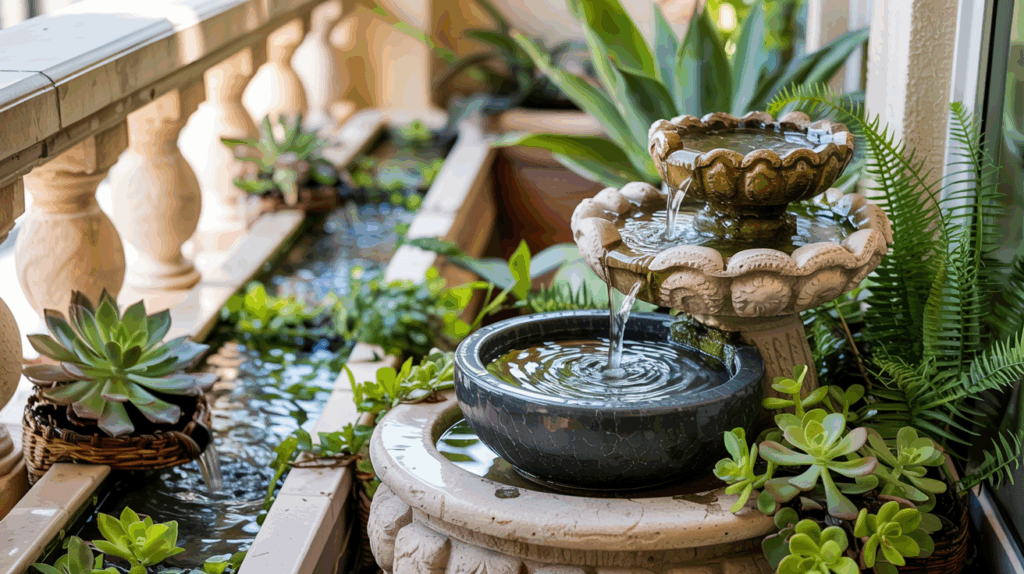I have been, or can be if you click on a link and make a purchase, compensated via a cash payment, gift, or something else of value for writing this post. As an Amazon Associate, I earn from qualifying purchases. Please read my full Affiliate Disclosure for more information.
To create a tranquil balcony with water, select compact, low-noise features that mount cleanly and resist weathering. Prioritize surface‑mount, tabletop, or wall‑integrated units that fit railing lines and avoid vibrations. Plan outlets and basins for gentle laminar flow, with adjustable rates to reduce splashing and fatigue. Use weather‑durable shells, seals, and modular components for easy maintenance. Pair with shade-tolerant plants and warm lighting, and you’ll establish a serene, cohesive microclimate that rewards further exploration.
Key Takeaways
- Choose compact, modular water features that mount or sit on surfaces to maximize balcony space and minimize vibration.
- Align outlets and basins with prevailing air currents to reduce splashing and promote gentle, laminar flow.
- Use weather-resistant materials with proper seals and corrosion-resistant finishes to ensure outdoor durability.
- Prioritize low-noise pumps and sound-damping design to achieve a tranquil, therapeutic soundscape.
- Pair with shade-tolerant plants and diffused lighting to maintain a cohesive, serene balcony environment.
Selecting Water Features for Small Balconies
When selecting water features for small balconies, prioritize compact, vibration-free options that maximize floor space and minimize water usage. You’ll assess pump efficiency, noise levels, and mounting flexibility to sustain a calm exterior. Favor modular units that blend with railing lines or concealment panels, ensuring maintenance convenience without visual clutter. Water fountain styles should emphasize surface mount, tabletop, or wall-integrated designs that reduce footprint while delivering audible serenity. Consider water feature accessories like discreet filtration, adjustable flow controls, and LED accents for atmosphere without bulk. Documentation: confirm compatibility with balcony load limits and local weather durability.

Placement and Flow: Designing Calm With Water
Placement and flow should be engineered to minimize perceptual noise while maximizing the sense of calm. You’ll locate the primary outlet and basin to align with prevailing air currents, reducing splashing and turbulence. Flow should be calibrated for gentle elevation changes and laminar transition, delivering a continuous, soft hiss rather than disruptive splashes. Consider setback distances from seating and thresholds to prevent overflow into pedestrian zones. Prioritize aesthetic enhancement by shaping flow paths that emphasize visual rhythm and reflective surface interaction. Design for seasonal adaptability with variable flow rates and cover options, ensuring tranquil perception across weather, wind, and sun.
Materials, Maintenance, and Durability
Selecting materials that withstand weathering while maintaining a coherent aesthetic is essential; lightweight, UV-stable composites and corrosion-resistant metals should dominate shell and basin construction, with joints and fasteners rated for outdoor exposure. You’ll prioritize waterproof materials for seals, gaskets, and liners to prevent leaks and minimize maintenance cycles. Choose modular components with consistent tolerances to ensure reliable fit and service life, and verify warranty coverage for outdoor use. Regular inspection intervals, simple cleaning protocols, and accessible drain paths reduce downtime. A well-specified water fountain system tolerates temperature swings, resists algae buildup, and preserves finish integrity over years.
Sound Management and Sensory Balance
Sound management on a balcony system hinges on controlling acoustic transmission and balancing ambient sound with the visual serenity of water; by isolating the basin from structural vibrations, selecting low-noise pumps, and using damping materials, you can achieve a predictable, tolerable sound profile. You’ll quantify noise reduction through vibration isolation, enclosure design, and piping topology, ensuring consistent performance across seasonal changes. Implement acoustic therapy principles to craft a therapeutic soundscape that complements water movement without overpowering surroundings. Prioritize component selection, maintenance access, and measurements, documenting baseline metrics to guide future adjustments and sustain long-term sensory balance.
Plant Pairings and Lighting for a Tranquil Space
Light, texture, and color from plants should support the balcony’s tranquil aesthetic while remaining low-maintenance; pairing foliage with appropriate lighting creates a cohesive microclimate that emphasizes calm and clarity. You’ll select plant combinations that thrive in your light conditions, favoring compact forms and varied leaf texture for visual depth. Align lighting design to plant needs: use diffused, warm-spectrum fixtures to reduce glare and enhance foliage color without promoting excessive growth. Emphasize consistent color palette and scale, integrating shade-tolerant species under overhangs and sun-loving accents near the water feature. Regular pruning maintains form and ensures sustained, serene balance.
Conclusion
To achieve a tranquil balcony with water features, prioritize compact, vibration-free units and airtight seals to minimize maintenance. Align placement with flow paths to guide air and sound subtly, avoiding sharp reflections. Use durable, corrosion-resistant materials and simple cleaning routines to sustain performance. Balance sound with plant volume and ambient lighting to create a nuanced acoustic environment. Consider modular components for easy upgrades, and document routine checks to preserve design intent and long-term stability.

Leave a Reply